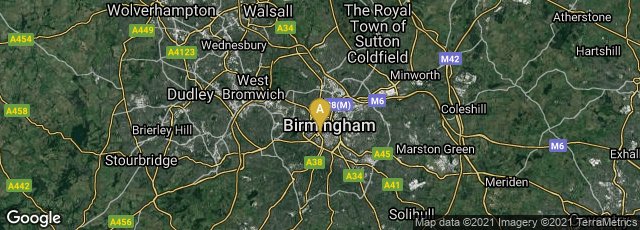

A: Birmingham, England, United Kingdom
Printer and typographer John Baskerville's deluxe edition of Virgil's Bucolica, Georgica et Aeneis of 1757 was his first publication, a project which he began in 1754, after he had made a fortune as an industrialist in Birmingham manufacturing japanned goods. The edition became famous for its typography and overall design; some authorities consider it Baskervile's finest work.
Baskerville's Virgil was also the first book of which part was printed on wove paper (velin) invented by English papermaker James Whatman. The edition was advertised for sale in the London Press on May 5, 1757. Because Whatman could supply only enough wove paper for part of the edition,
"the first 28 sheets (A-2E) were printed on an unwatermarked wove paper, the remainder (2F-3H, Π-b) on an unwatermarked laid paper. At some time after the change from wove to laid paper a number of sheets and individual leaves were cancelled, those in the wove sections being identifiable through the cancellantia being printed on laid paper. Some of these cancels are found in nearly all copies of the book, some in only a few" (Gaskell, John Baskerville: A Bibliography [1959] no. 1).
The wove paper Whatman produced for this edition was a preliminary form:
"Apropos of the claim . . . that Baskerville's quarto Virgil of 1757 is printed on the first known specimen of western wove paper, it can be said without hesitation that the characteristics of this paper are unique. It is quite unlike the more successful wove papers that followed in having unmistakable wiremarks and flaws" (Balston, The Whatmans and Wove (Velin) Paper [1998] xxxv).
"In this Virgil, his first book, the 'amateur' Baskerville shows an assurance one would have expected from a highly experienced master . . . His use of his own, freshly created type, with its balance between the subtlety of the earlier printers' designs and the harsh new French types, is exemplary. . . The skill seen here is especially remarkable, for such simplicity, even minimalism, was revolutionary. It was a defining moment in bookmaking, ridding it of the irrelevant, flowery decoration . . . The repercussions were to be felt not only in Britain, but in continental Europe, and even in America." (Bartram, Five Hundred Years of Book Design, 70-71).
Though book historians draw attention to the first use of wove paper in the first Baskerville edition of Virgil, there is no evidence that Baskerville was especially interested in this innovation in paper. Most of his later books were printed on the traditional laid paper. Besides the innovative typography and book design involved, Baskerville's first edition of Virgil was also known for the "glazed" surface of the paper. The exact method by which Baskerville glazed or hot-pressed his book-paper was a trade secret that Baskerville never revealed. As a result, extensive research by historians of printing and paper has been devoted to possible techniques involved; see Balston, op. cit (1998) 27-28, 217-224.
Eventually after the first edition of his 1757 4to Virgil was sold out, Baskerville published a second edition, produced in facsimile to the first. The precise date of this second edition, called by some a "forgery," is unknown, but it has been estimated to be around 1770. Among the ways it can be distinguished from the first edition is that is printed entirely on laid rather than wove paper. Determining the original printing from the early facsimile edition also requires attention to subtle bibliographical details cited in Gaskell's bibliography referenced above.
Pardoe, John Baskerville of Birmingham, Letter-Founder & Printer (1975).
Archer-Parré, Caroline & Dick, Malcolm, eds. John Baskerville: Art and Industry of the Enlightenment (2017).